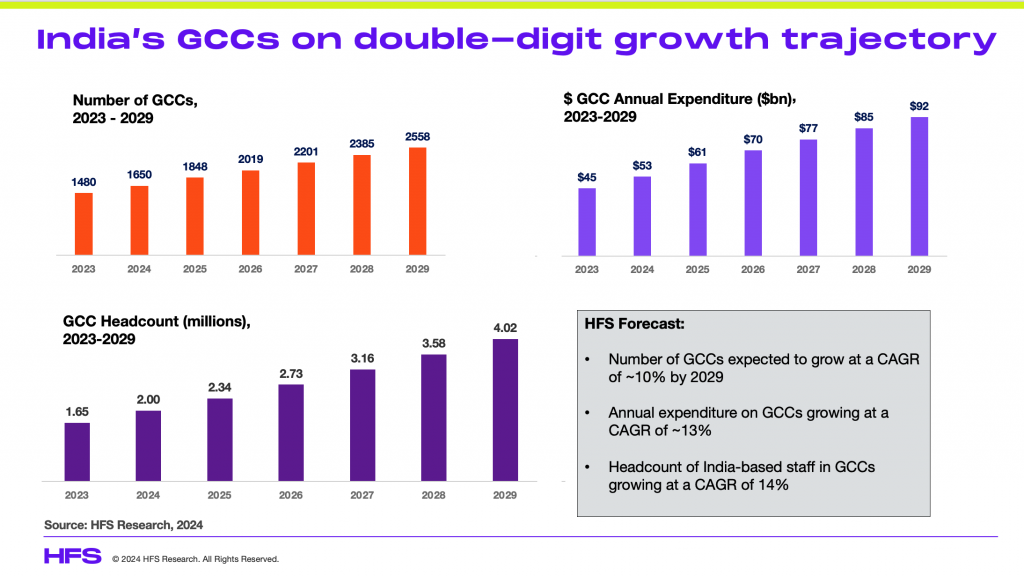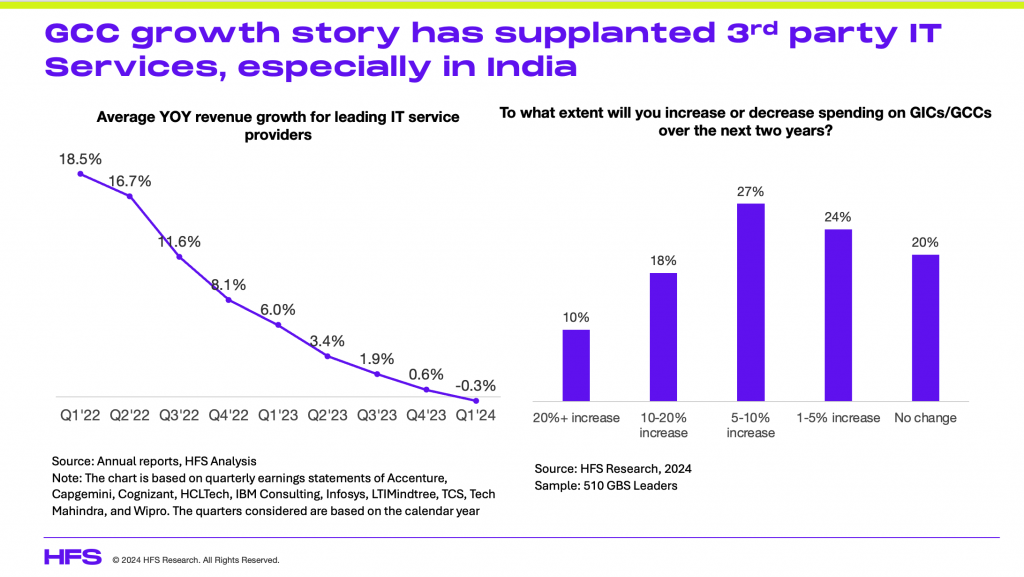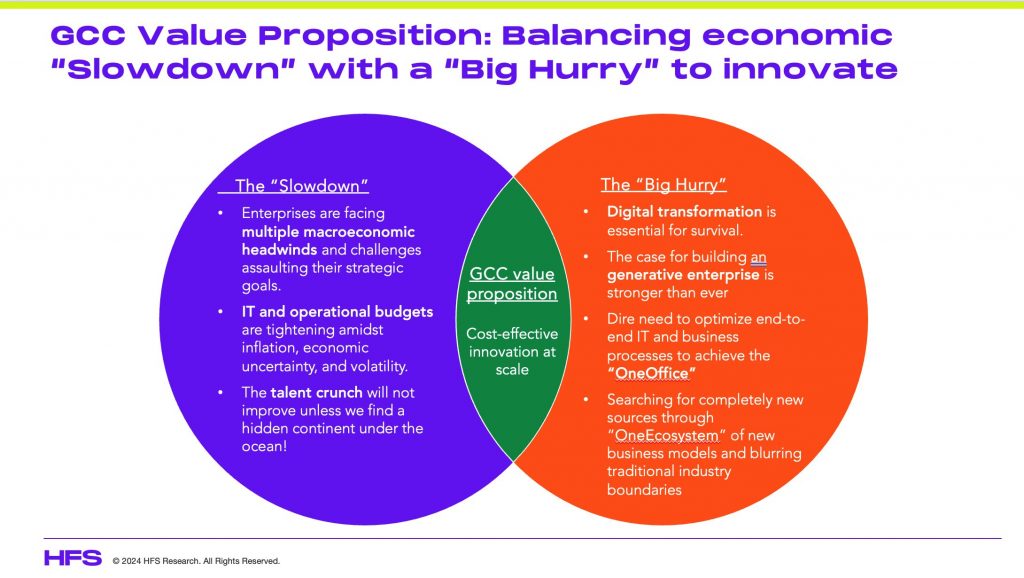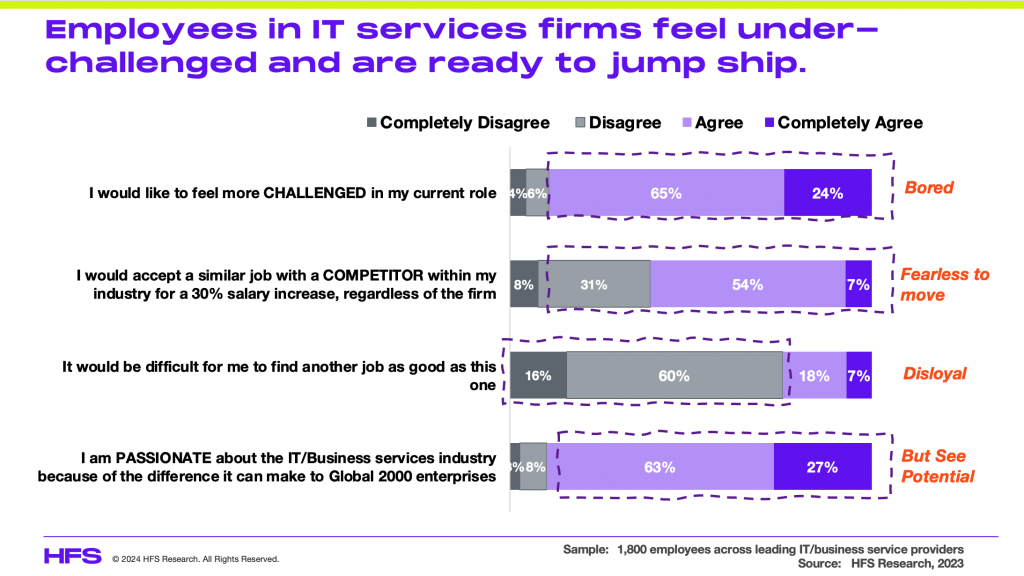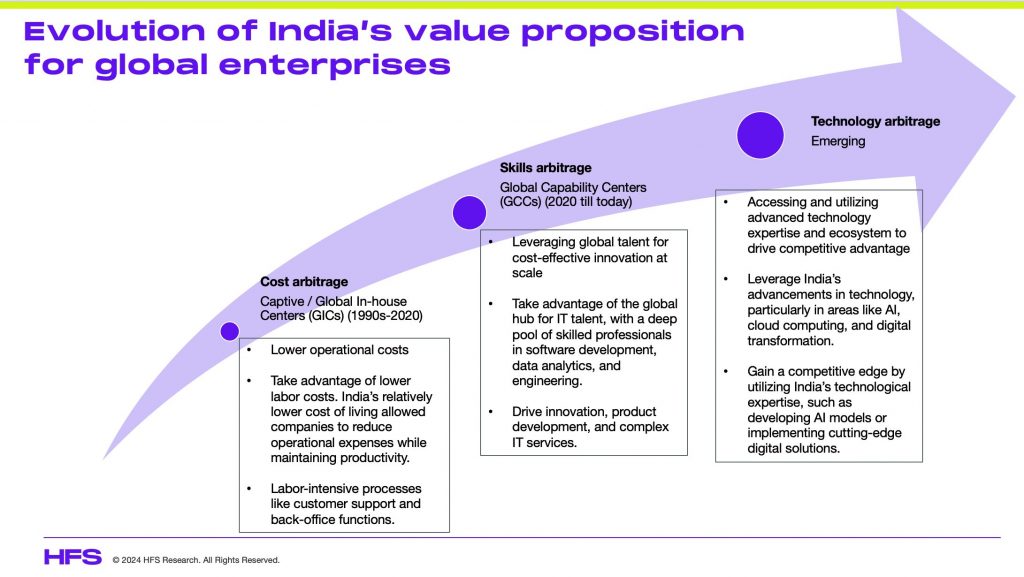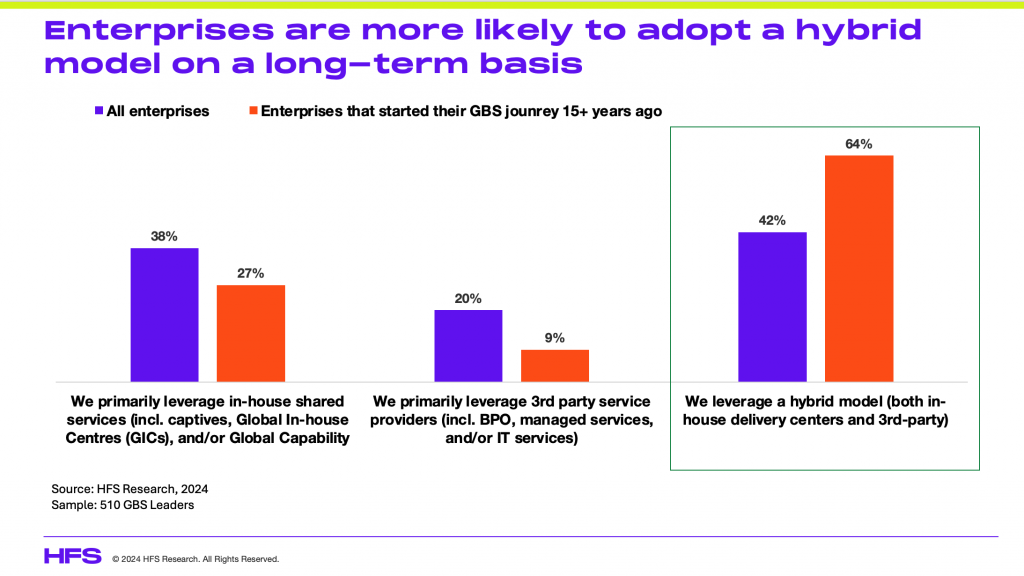Global Capability Centers (GCCs) have emerged as the trailblazers of the Indian IT landscape, displaying extraordinary double-digit growth and transformation and carving out a distinct and powerful niche. While tech and BPO service providers have grappled with flagging enterprise demand and other market pressures, GCCs have thrived, with HFS estimating 2000 expected to be in full operation in 2025. So, are these GCCs genuinely the new face of Indian IT?
Let’s discuss:
GCCs thrive while third-party providers struggle
The rise of GCCs has been nothing short of meteoric. As third-party tech and BPO service providers navigate turbulent waters, GCCs are scaling new heights. The numbers speak volumes: HFS estimates show 1,650 GCCs established in India (growing at 11% this year), employing around 1.6 million people, with 120 new GCCs launched just in the first half of 2024 alone. HFS estimates over 2.7 million people will occupy India’s GCCs by the end of 2026, which could top 4 million staff by 2029. In addition, annual spending in GCCs will move past $50 billion this year and could almost double over the next five years.
Net-net, this explosive growth has redefined India’s tech industry and is being driven by rampant expansion across India’s leading tier 1 and tier 2 cities for talent:
The secret? Effective GCCs are much more closely integrated with their parent organizations, aligning with corporate goals, which ensures optimal resource allocation, effective project management, and a profound understanding of their parent company’s culture and objectives. In short, many global decision-makers within the Global 2000 feel much more in control over their operations in a market of rampant technological development and economic uncertainty:
GCCs are shifting the “Why India” question from Cost Arbitrage to Skills Arbitrage
The GCC model is not new (remember “captives” and Global In-house Centers/GICs), but its value proposition has been evolving significantly in recent times. Initially seen as cost-saving centers, GCCs have transitioned to a focus on skills arbitrage. India’s deep reservoir of skilled IT professionals now promises something far more valuable: cost-effective innovation at scale. This pivot has rebranded the “Why India” narrative from a mere cost-saving exercise to a strategy of substantial value creation—a vital advantage for enterprises caught in the “digital dichotomy,” struggling to balance macroeconomic challenges with the need for relentless innovation:
GCCs are making IT services sexy again for Top-Tier Indian Talent
The Indian IT services industry has long faced challenges in attracting top-tier talent, with the best and brightest often gravitating toward startups or global technology providers. Our study of 1,800 IT services employees last year revealed widespread dissatisfaction, with many feeling under-challenged and ready to jump ship (See exhibit below). The problem with the services industry is that when companies provide outsourced services for enterprise customers, it’s most often the monotonous tasks the customer can offload at scale, such as application testing, infrastructure monitoring, accounts payables or receivables.
Even sexier-sounding work, such as content moderation for social media sites or product support services, is usually very tedious after a while, especially when the services worker is just instructed to follow a standard operating procedure without any incentives to use judgment, creativity, analytical skill, or common sense. It’s no wonder staff have been quitting in droves in search of something more challenging when there is so much demand for workers to perform higher-impact work elsewhere. Now that their next job may turn out no more challenging than their current gig if there’s 30% more money for doing it, why not?
In short, employees do not like their current employers because of their lack of career growth opportunities, bureaucratic company cultures, difficulties finding the right work-life balance, and disillusionment with the company’s purpose and vision:
As you can see, close to 9 out of 10 staff want to feel more challenged (and are bored), 61% will jump to a competitor for a pay hike, and 75% believe they can easily find a job as good as the one they currently have. The only saving grace for the IT and Business services industry is that 90% of employees are passionate about the impact they can have on enterprise clients. The simple fact that GCCs offer the chance for Indian talent to get closer to global enterprises and have a more direct impact on their clients (true OneOffice) is making the GCC career option far more attractive than many of these “back office” service provider roles.
GCCs are reversing this trend. Offering up to 30% higher salaries, often more challenging roles, and opportunities to work with cutting-edge technologies and prestigious institutions, GCCs are making IT services desirable once again. This resurgence in interest is not only enhancing GCC capabilities but also elevating the entire Indian IT industry, especially during these challenging times for its traditional outsourcing market.
HFS Recommendations for Long-Term Success with the GCC Model
GCCs have rightly earned the spotlight, but to sustain their momentum, they must continue to innovate. The future is promising, but complacency is the enemy. Here’s what they need to do:
1. Embrace India’s blossoming AI talent to drive Technology Arbitrage
GCCs are accelerating India’s value proposition from cost to skills arbitrage. Now, they must embrace AI to unlock the potential of technology arbitrage, positioning themselves not just as cost-effective hubs but as epicenters of technological innovation (See below). No region in the world comes close to India to develop talent at scale, which can learn the latest GenAI and machine learning tool. The booming startup ecosystem and ambitious numbers of college graduates place India in an ideal position to dominate the future of AI development, with GCCs at the core.
If this shift is managed effectively, it will transform many GCCs from support centers to strategic drivers of global business value, supporting companies to optimize processes, predict market trends, and respond to changing consumer needs to create new revenue streams. This shift would not only enhance the competitive edge of their parent organizations but also establish many GCCs as leaders in the global technology landscape. The challenge is centered on transitioning from a people-centric model to a technology-driven one, but the rewards are immense if you can adopt the right mindset for change and innovation.
2. Benefit from a Hybrid Model of in-house capabilities AND third-party services
The future is hybrid. While 40% of Global 2000 enterprises use a hybrid model, this figure jumps to nearly 65% for those with over 15 years in the game (See below). On a long-term basis, companies are more likely to adopt a hybrid model, due to their need for greater flexibility and the ability to balance cost-efficiency with specialized expertise. A hybrid model that combines in-house capability centers with third-party services can offer the best of both worlds. This approach allows for flexibility, scalability, and access to a broader range of expertise and resources, enhancing overall service delivery and innovation capacity. The conversation should not be “In-house OR 3rd parties” but “In-house AND 3rd parties.” The hybrid model offers the flexibility and scalability that today’s dynamic business environment demands. It’s not a choice between in-house and third-party services—it’s about integrating both to create a more robust, versatile operation.
3. Make GCCs a vital part of the Corporate Innovation Agenda
GCCs are often perceived as execution engines rather than innovation leaders, including instances where GCCs are primarily tasked with implementing strategies and projects designed by the parent company rather than driving the ideation and development of those strategies. For example, a GCC might be responsible for scaling a software development project globally, but the core innovation and design decisions are made at the headquarters.
GCCs should aim higher than executing the corporate innovation agenda set by their parent companies. They should aspire to create this agenda, leading the way in identifying new opportunities, technologies, and market trends. By taking a proactive role in innovation, GCCs can become indispensable partners to their parent organizations, driving strategic initiatives and long-term growth.
The key challenge here is to establish stronger lines of collaboration between GCC leaders and the enterprise leaders in corporate. This is usually a result of legacy-minded corporations who traditionally treat Indian resources as “back office” as opposed to being part of the broader corporate mission. Smart enterprise operation leaders need to establish clear skills development programs and career paths to encourage more Indian staff to establish themselves as strategic workers forming part of global teams. This is where enterprises, in general, need to invest in a global talent model and ensure the GCC is fully integrated with the rest of the enterprise and not sectioned off as a support center.
Bottom line: It’s time to elevate GCCs from execution engines to innovation leaders
Global Capability Centers (GCCs) have become a pivotal force in the Indian IT industry, driving operational excellence and innovation at scale. However, to sustain their success and continue leading the charge in global technology services, GCCs must evolve significantly beyond their current roles.
Embracing AI and shifting towards a technology-driven model will position GCCs as epicenters of innovation rather than mere execution engines. Moreover, adopting a hybrid model that integrates in-house capabilities with third-party services will provide the flexibility and scalability needed in a dynamic business environment. Finally, GCCs should not simply implement the corporate innovation agenda but also aspire to help create it, thereby becoming indispensable partners in shaping the future of their parent organizations. The time is ripe for GCCs to transition from cost and skills arbitrage to full-fledged technology arbitrage, ensuring long-term growth and global leadership.
At HFS, we are diving deeper into this exciting GCC space. Watch out for our upcoming videocast series with GCC leaders, our GCC executive roundtable in Bengaluru, and our HFS Summit in India next February.
Posted in : Automation, Business Process Outsourcing (BPO), Buyers' Sourcing Best Practices, Captives and Shared Services Strategies, Employee Experience, GCCs, IT Outsourcing / IT Services


